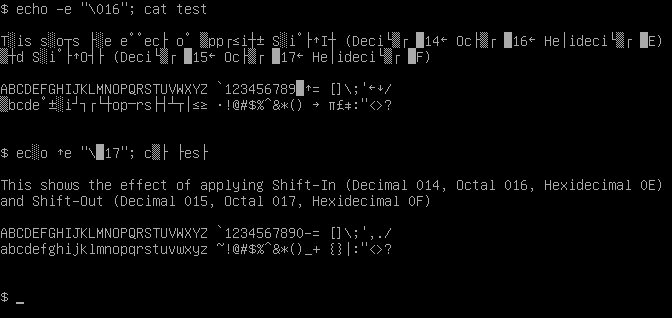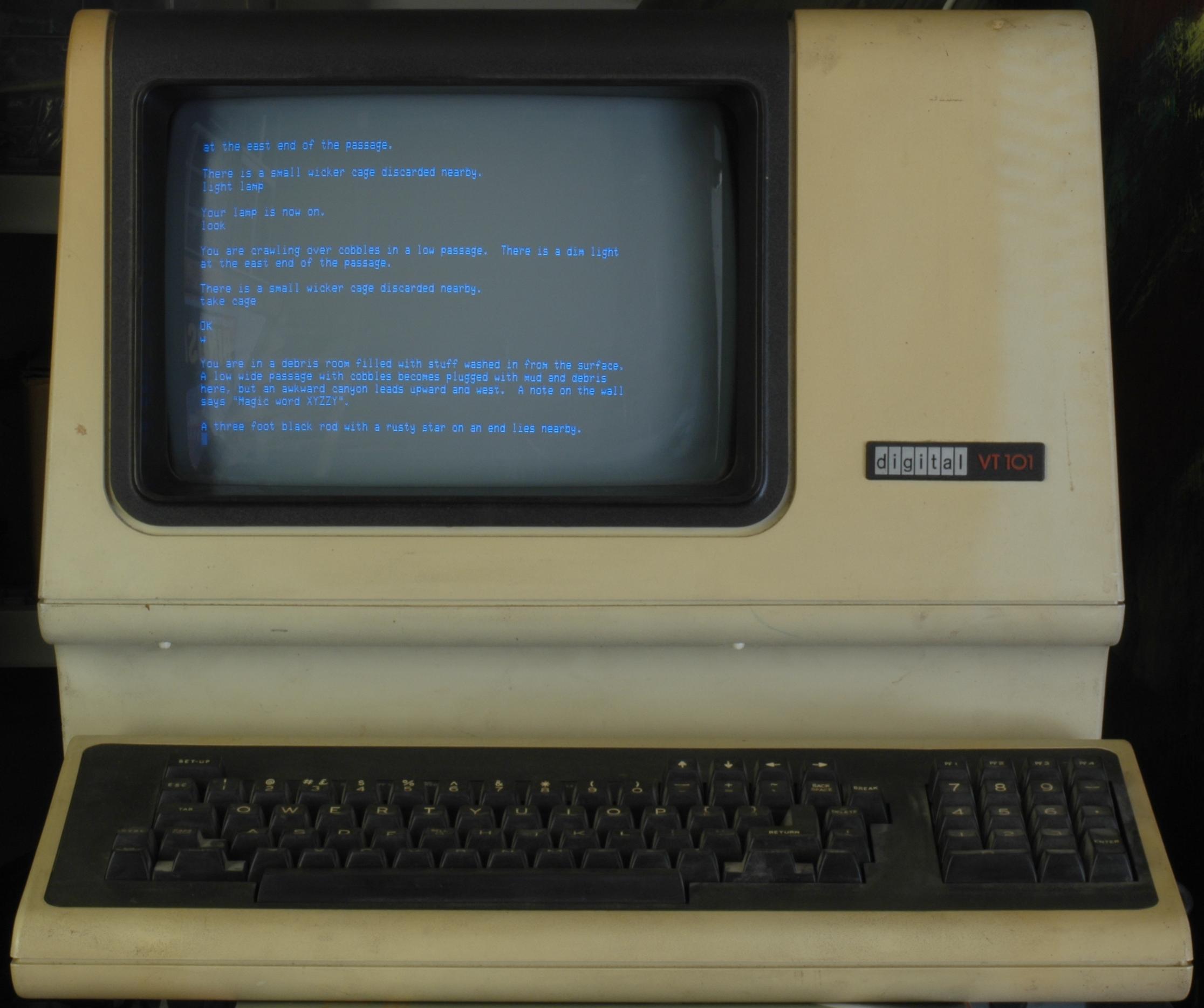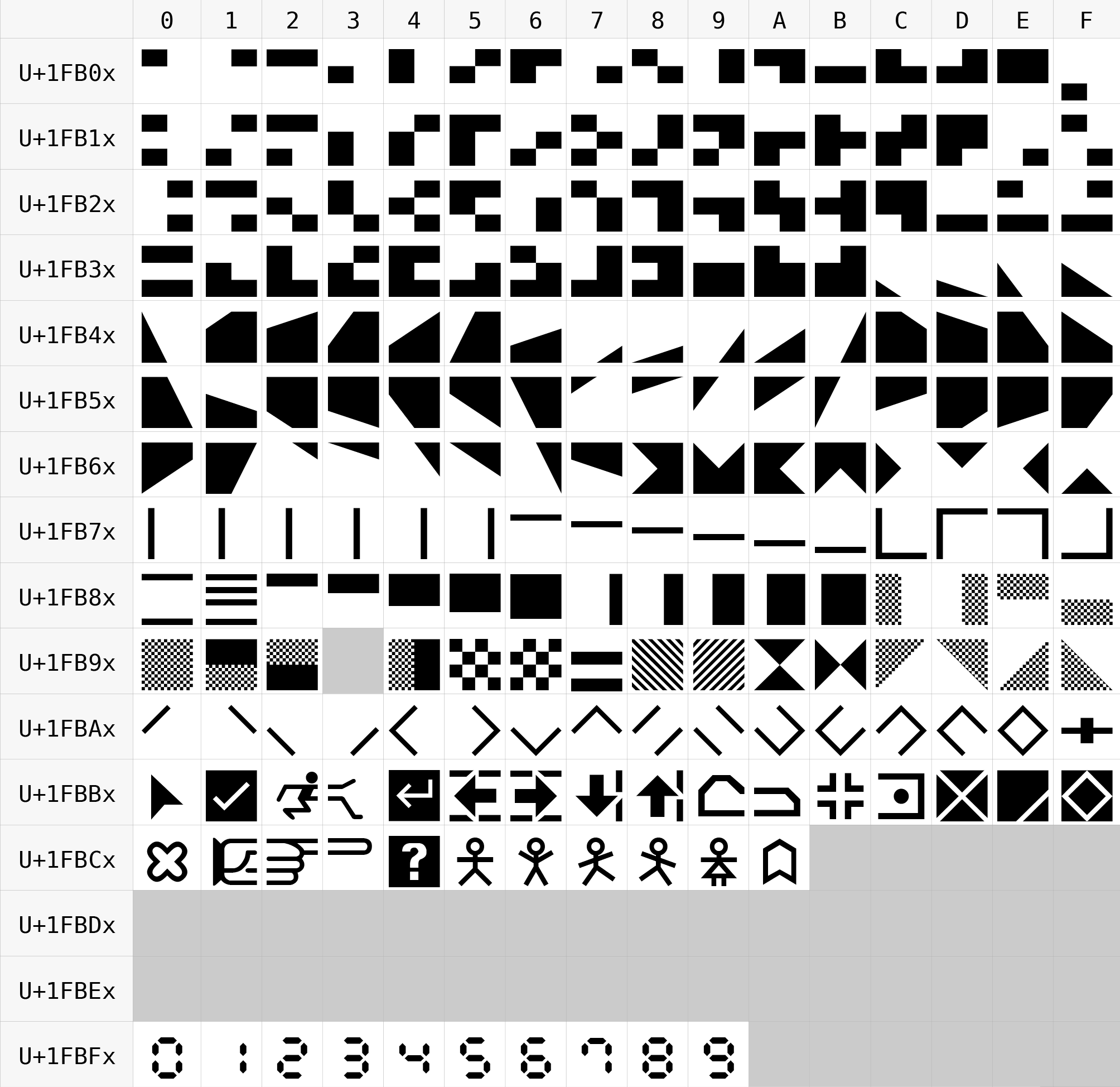|
DEC Special Graphics
DEC Special Graphics is a 7-bit character set developed by Digital Equipment Corporation. This was used very often to draw box-drawing characters, boxes on the VT100 video terminal and the many emulators, and used by bulletin board software. The ISO/IEC 2022#Character set designations, designation escape sequence (hexadecimal ) switched the codes for lower-case ASCII letters to draw this set, and the sequence (hexadecimal ) switched back. IBM calls it Code page 1090. Character set See also *DEC Multinational Character Set (MCS) *DEC National Replacement Character Set (NRCS) *DEC Technical Character Set *DEC VT100 *Box-drawing character Footnotes References {{character encoding Character sets Digital Equipment Corporation ... [...More Info...] [...Related Items...] OR: [Wikipedia] [Google] [Baidu] |
Shift Out
Shift Out (SO) and Shift In (SI) are ASCII control characters 14 and 15, respectively (0x0E and 0x0F). These are sometimes also called "Control-N" and "Control-O". The original meaning of those characters provided a way to shift a coloured ribbon, split longitudinally usually with red and black, up and down to the other colour in an electro-mechanical typewriter or teleprinter, such as the Teletype Model 38, to automate the same function of manual typewriters. Black was the conventional ambient default colour and so was shifted "in" or "out" with the other colour on the ribbon. Later advancements in technology instigated use of this function for switching to a different font or character set and back. This was used, for instance, in the Russian character set known as KOI7-switched, where SO starts printing Russian letters, and SI starts printing Latin letters again. Similarly, they are used for switching between Katakana and Roman letters in the 7-bit version of the Japanese JIS ... [...More Info...] [...Related Items...] OR: [Wikipedia] [Google] [Baidu] |
Unicode Consortium
The Unicode Consortium (legally Unicode, Inc.) is a 501(c)(3) non-profit organization incorporated and based in Mountain View, California. Its primary purpose is to maintain and publish the Unicode Standard which was developed with the intention of replacing existing character encoding schemes which are limited in size and scope, and are incompatible with multilingual environments. The consortium describes its overall purpose as: Unicode's success at unifying character sets has led to its widespread adoption in the internationalization and localization of software. The standard has been implemented in many technologies, including XML, the Java programming language, Swift, and modern operating systems. Voting members include computer software and hardware companies with an interest in text-processing standards, including Adobe, Apple, the Bangladesh Computer Council, Emojipedia, Facebook, Google, IBM, Microsoft, the Omani Ministry of Endowments and Religious Affairs, Monotype ... [...More Info...] [...Related Items...] OR: [Wikipedia] [Google] [Baidu] |
Box-drawing Character
Box-drawing characters, also known as line-drawing characters, are a form of semigraphics widely used in text user interfaces to draw various geometric frames and boxes. Box-drawing characters typically only work well with monospaced fonts. In graphical user interfaces, these characters are much less useful as it is more simple and appropriate to draw lines and rectangles directly with graphical APIs. However, they are still useful for command-line interfaces and plaintext comments within source code. Used along with box-drawing characters are block elements, shade characters, and terminal graphic characters, these can be used for filling regions of the screen and portraying drop shadows. Encodings Unicode Box Drawing Unicode includes 128 such characters in the Box Drawing block. In many Unicode fonts only the subset that is also available in the IBM PC character set (see below) will exist, due to it being defined as part of the WGL4 character set. The image below is provi ... [...More Info...] [...Related Items...] OR: [Wikipedia] [Google] [Baidu] |
DEC VT100
The VT100 is a video terminal, introduced in August 1978 by Digital Equipment Corporation (DEC). It was one of the first terminals to support ANSI escape codes for cursor control and other tasks, and added a number of extended codes for special features like controlling the status lights on the keyboard. This led to rapid uptake of the ANSI standard, which became the de facto standard for hardware video terminals and later terminal emulators. The VT100 series, especially the VT102, was extremely successful in the market, and made DEC the leading terminal vendor at the time. The VT100 series was replaced by the VT200 series starting in 1983, which proved equally successful. Ultimately, over six million terminals in the VT series were sold, based largely on the success of the VT100. Description DEC's first video terminal was the VT05 (1970), succeeded by the VT50 (1974), and soon upgraded to the VT52 (1975). The VT52 featured a text display with 80 columns and 24 rows, bidirection ... [...More Info...] [...Related Items...] OR: [Wikipedia] [Google] [Baidu] |
DEC Technical Character Set
DEC Technical (TCS) is a 7-bit character set developed by Digital Equipment Corporation. Character set � Characters from 31 to 37 are intended to assemble a 3x5 uppercase sigma and do not have Unicode equivalents. See also *DEC Multinational Character Set (MCS) * DEC National Replacement Character Set (NRCS) *DEC Special Graphics DEC Special Graphics is a 7-bit character set developed by Digital Equipment Corporation. This was used very often to draw box-drawing characters, boxes on the VT100 video terminal and the many emulators, and used by bulletin board software. The IS ... * Symbol (typeface) § Encoding References Further reading * {{character encoding Character sets Digital Equipment Corporation ... [...More Info...] [...Related Items...] OR: [Wikipedia] [Google] [Baidu] |
DEC National Replacement Character Set
The National Replacement Character Set (NRCS) was a feature supported by later models of Digital's (DEC) computer terminal systems, starting with the VT200 series in 1983. NRCS allowed individual characters from one character set to be replaced by one from another set, allowing the construction of different character sets on the fly. It was used to customize the character set to different local languages, without having to change the terminal's ROM for different countries, or alternately, include many different sets in a larger ROM. Many 3rd party terminals and terminal emulators supporting VT200 codes also supported NRCS. Description ASCII is a 7-bit standard, allowing a total of 128 characters in the character set. Some of these are reserved as control characters, leaving 96 printable characters. This set of 96 printable characters includes upper and lower case letters, numbers, and basic math and punctuation. ASCII does not have enough room to include other common characters s ... [...More Info...] [...Related Items...] OR: [Wikipedia] [Google] [Baidu] |
DEC Multinational Character Set
The Multinational Character Set (DMCS or MCS) is a character encoding created in 1983 by Digital Equipment Corporation (DEC) for use in the popular VT220 terminal. It was an 8-bit extension of ASCII that added accented characters, currency symbols, and other character glyphs missing from 7-bit ASCII. It is only one of the code pages implemented for the VT220 National Replacement Character Set (NRCS). MCS is registered as IBM code page/CCSID 1100 (Multinational Emulation) since 1992. Depending on associated sorting Oracle calls it WE8DEC, N8DEC, DK8DEC, S8DEC, or SF8DEC. Such "extended ASCII" sets were common (the National Replacement Character Set provided sets for more than a dozen European languages), but MCS has the distinction of being the ancestor of ECMA-94 in 1985 and ISO 8859-1 in 1987. The code chart of MCS with ECMA-94, ISO 8859-1 and the first 256 code points of Unicode have many more similarities than differences. In addition to unused code points, differences from I ... [...More Info...] [...Related Items...] OR: [Wikipedia] [Google] [Baidu] |
Pi (letter)
Pi (uppercase Π, lowercase π and ϖ; el, πι ) is the sixteenth letter of the Greek alphabet, representing the voiceless bilabial plosive . In the system of Greek numerals it has a value of 80. It was derived from the Phoenician letter Pe (). Letters that arose from pi include Latin P, Cyrillic Pe (П, п), Coptic pi (Ⲡ, ⲡ), and Gothic pairthra (𐍀). Uppercase Pi The uppercase letter Π is used as a symbol for: * In textual criticism, '' Codex Petropolitanus'', a 9th-century uncial codex of the Gospels, now located in St. Petersburg, Russia. * In legal shorthand, it represents a plaintiff. In science and engineering: * The product operator in mathematics, indicated with capital pi notation (in analogy to the use of the capital Sigma as summation symbol). * The osmotic pressure in chemistry. * The viscous stress tensor in continuum mechanics and fluid dynamics. Lowercase Pi The lowercase letter π is used as a symbol for: * The mathematical real transcen ... [...More Info...] [...Related Items...] OR: [Wikipedia] [Google] [Baidu] |
Inequality (mathematics)
In mathematics, an inequality is a relation which makes a non-equal comparison between two numbers or other mathematical expressions. It is used most often to compare two numbers on the number line by their size. There are several different notations used to represent different kinds of inequalities: * The notation ''a'' ''b'' means that ''a'' is greater than ''b''. In either case, ''a'' is not equal to ''b''. These relations are known as strict inequalities, meaning that ''a'' is strictly less than or strictly greater than ''b''. Equivalence is excluded. In contrast to strict inequalities, there are two types of inequality relations that are not strict: * The notation ''a'' ≤ ''b'' or ''a'' ⩽ ''b'' means that ''a'' is less than or equal to ''b'' (or, equivalently, at most ''b'', or not greater than ''b''). * The notation ''a'' ≥ ''b'' or ''a'' ⩾ ''b'' means that ''a'' is greater than or equal to ''b'' (or, equivalently, at least ''b'', or not less than ''b''). The re ... [...More Info...] [...Related Items...] OR: [Wikipedia] [Google] [Baidu] |
Halfwidth And Fullwidth Forms
In CJK (Chinese, Japanese and Korean) computing, graphic characters are traditionally classed into fullwidth (in Taiwan and Hong Kong: 全形; in CJK: 全角) and halfwidth (in Taiwan and Hong Kong: 半形; in CJK: 半角) characters. Unlike monospaced fonts, a halfwidth character occupies half the width of a fullwidth character, hence the name. ''Halfwidth and Fullwidth Forms'' is also the name of a Unicode block U+FF00–FFEF, provided so that older encodings containing both halfwidth and fullwidth characters can have lossless translation to/from Unicode. Rationale In the days of text mode computing, Western characters were normally laid out in a grid on the screen, often 80 columns by 24 or 25 lines. Each character was displayed as a small dot matrix, often about 8 pixels wide, and a SBCS (single-byte character set) was generally used to encode characters of Western languages. For aesthetic reasons and readability, it is preferable for Han characters to be approxim ... [...More Info...] [...Related Items...] OR: [Wikipedia] [Google] [Baidu] |
Japanese Language In EBCDIC
Several mutually incompatible versions of the Extended Binary Coded Decimal Interchange Code (EBCDIC) have been used to represent the Japanese language on computers, including variants defined by Hitachi, Fujitsu, IBM and others. Some are variable-width encodings, employing locking shift codes to switch between single-byte and double-byte modes. Unlike other EBCDIC locales, the lowercase basic Latin letters are often not preserved in their usual locations. The characters which are found in the double-byte Japanese code used with EBCDIC by IBM, but not found in the first edition of JIS X 0208, also influenced the vendor extensions found in some non-EBCDIC encodings such as IBM code page 932 ("DBCS-PC") and Windows code page 932. Single-byte codes Similarly to JIS X 0201 (itself incorporated into Shift JIS), Japanese EBCDIC encodings often include a set of single-byte katakana. Several different variants of the single-byte EBCDIC code are used in the Japanese locale, by differe ... [...More Info...] [...Related Items...] OR: [Wikipedia] [Google] [Baidu] |
Symbols For Legacy Computing
Symbols for Legacy Computing is a Unicode block containing graphic characters that were used for various home computers from the 1970s and 1980s and in Teletext broadcasting standards. It includes characters from the Amstrad CPC, MSX, Mattel Aquarius, RISC OS, MouseText, Atari ST, TRS-80 Color Computer, Oric, Texas Instruments TI-99/4A, TRS-80, Minitel, Teletext, ATASCII, PETSCII, ZX80, and ZX81 character sets, as well as semigraphics characters. Block The image below is provided as quick reference for these symbols on systems that are unable to display them directly: : History The following Unicode-related documents record the purpose and process of defining specific characters in the Symbols for Legacy Computing block: See also * Supplemental Arrows-C Unicode block characters and * Block Elements Block Elements is a Unicode block containing square block symbols of various fill and shading. Used along with block elements are box-drawing characters, shade character ... [...More Info...] [...Related Items...] OR: [Wikipedia] [Google] [Baidu] |




.png)
